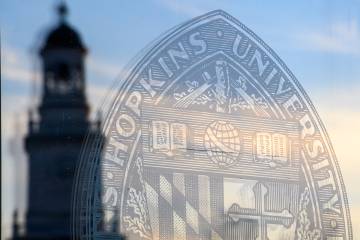The release of Johns Hopkins' second diversity, equity, and inclusion plan last winter has been followed by a flurry of sustained activity over the past several months, as leaders, DEI practitioners, and others across the university work toward the 24 goals articulated in the document.
Realizing our Promise: The Second JHU Roadmap on Diversity, Equity, and Inclusion, JHU's vision for advancing diversity, equity, and inclusion across the university over the next five years, is an ambitious and wide-ranging document that aims to build on the progress of JHU's first diversity plan, to address identified gaps, and to elevate the university's diversity efforts to a new level.
"At Johns Hopkins we strive to be a model of a pluralistic society in which we acknowledge, embrace, and engage diverse identities, perspectives, and experiences," begins the new universitywide Statement of Principles on Diversity, Equity, and Inclusion, an important foundational milestone for diversity strategic planning activities across the university that was adopted in December when JHU's board of trustees endorsed the Roadmap. "We seek to build and buttress an inclusive intellectual and physical environment to ensure that all members of our community know with certainty that they belong at Johns Hopkins. And we aspire to equitably share the benefits and burdens of dismantling persistent systemic barriers to individual and communal success."
To that end, the Office of Diversity and Inclusion has been leading ongoing implementation planning at both the university and divisional levels to outline the steps needed to accomplish the Roadmap goals. ODI has shared a preliminary timeline for the plan, culminating in the university's first annual Diversity, Equity and Inclusion Summit, to be held in the fall of 2023.
"This Roadmap reflects a deliberative and inclusive process shaped by the insights and ideas of a broad and diverse group of Hopkins employees, students, alumni, and neighbors," said Katrina Caldwell, the university's vice provost for diversity and inclusion and chief diversity officer. "But our work is just beginning—reaching these goals and realizing the full promise of this institution will require collaboration, accountability, and a shared commitment to building a culture of belonging and success for all."
Notably, two programs that aim to bring diverse scholars to the university's campuses, with a particular focus in science, technology, engineering, and math fields, made major strides in recent months. The Vivien Thomas Scholars Initiative, a $150 million effort to address historic underrepresentation in STEM disciplines, has welcomed an inaugural cohort of 20 scholars from a group of more than 200 applicants. These scholars, recruited from historically black colleges and universities and minority serving institutions, will arrive later this summer to begin pursuing Hopkins PhDs in STEM fields.
A complementary faculty recruiting effort, the Fannie Gaston-Johansson Faculty of Excellence Program, was announced in May. This program—named for longtime School of Nursing faculty member Fannie Gaston-Johansson, the first Black woman to become a tenured professor at Johns Hopkins—will bring 30 diverse scholars to the university, with a concentration in areas where diversity among faculty has lagged, particularly in the natural and biological sciences.
Additional progress related to the Roadmap's 24 institutional goals includes:
- The creation of the $5 million PhD Pathways Innovation Fund to support the establishment of summer and post-baccalaureate PhD pathway programs in non-STEM fields for students from backgrounds underrepresented in academia. Proposals were due at the end of May, and the university will select between three and five programs from across the university to receive seed grant funding of up to $1.2 million over five years.
- The expansion of gender-affirming care benefits and supports for employees, students, and others who use Johns Hopkins-provided health insurance plans. All plans—most of which previously offered coverage for gender-affirming surgeries in addition to hormone therapy—have extended coverage to include additional gender-affirming care procedures, namely voice therapy and facial reconstructive procedures.
- Initial steps toward the creation of two new advisory bodies—the student advisory committee and the staff advisory council—that will identify matters of importance to their respective communities and provide feedback to university leadership. Planning committees for both groups are expected to convene in the fall, with representation from across the university.
Academic and operational divisional partners are currently preparing and finalizing their goals to be shared broadly later this semester.
More information about the Roadmap is available on the university's Diversity and Inclusion website, including a high-level implementation timeline and a status update on 10 goals identified for early action. Timelines for the Roadmap's full set of 24 goals will be posted later this semester.
Posted in University News
Tagged diversity









